Alejandro Bellogín
Impacts of Mainstream-Driven Algorithms on Recommendations for Children Across Domains: A Reproducibility Study
Jul 09, 2025Abstract:Children are often exposed to items curated by recommendation algorithms. Yet, research seldom considers children as a user group, and when it does, it is anchored on datasets where children are underrepresented, risking overlooking their interests, favoring those of the majority, i.e., mainstream users. Recently, Ungruh et al. demonstrated that children's consumption patterns and preferences differ from those of mainstream users, resulting in inconsistent recommendation algorithm performance and behavior for this user group. These findings, however, are based on two datasets with a limited child user sample. We reproduce and replicate this study on a wider range of datasets in the movie, music, and book domains, uncovering interaction patterns and aspects of child-recommender interactions consistent across domains, as well as those specific to some user samples in the data. We also extend insights from the original study with popularity bias metrics, given the interpretation of results from the original study. With this reproduction and extension, we uncover consumption patterns and differences between age groups stemming from intrinsic differences between children and others, and those unique to specific datasets or domains.
Understanding the Influence of Data Characteristics on the Performance of Point-of-Interest Recommendation Algorithms
Nov 13, 2023Abstract:The performance of recommendation algorithms is closely tied to key characteristics of the data sets they use, such as sparsity, popularity bias, and preference distributions. In this paper, we conduct a comprehensive explanatory analysis to shed light on the impact of a broad range of data characteristics within the point-of-interest (POI) recommendation domain. To accomplish this, we extend prior methodologies used to characterize traditional recommendation problems by introducing new explanatory variables specifically relevant to POI recommendation. We subdivide a POI recommendation data set on New York City into domain-driven subsamples to measure the effect of varying these characteristics on different state-of-the-art POI recommendation algorithms in terms of accuracy, novelty, and item exposure. Our findings, obtained through the application of an explanatory framework employing multiple-regression models, reveal that the relevant independent variables encompass all categories of data characteristics and account for as much as $R^2 = $ 85-90\% of the accuracy and item exposure achieved by the algorithms. Our study reaffirms the pivotal role of prominent data characteristics, such as density, popularity bias, and the distribution of check-ins in POI recommendation. Additionally, we unveil novel factors, such as the proximity of user activity to the city center and the duration of user activity. In summary, our work reveals why certain POI recommendation algorithms excel in specific recommendation problems and, conversely, offers practical insights into which data characteristics should be modified (or explicitly recognized) to achieve better performance.
Challenging the Myth of Graph Collaborative Filtering: a Reasoned and Reproducibility-driven Analysis
Aug 01, 2023Abstract:The success of graph neural network-based models (GNNs) has significantly advanced recommender systems by effectively modeling users and items as a bipartite, undirected graph. However, many original graph-based works often adopt results from baseline papers without verifying their validity for the specific configuration under analysis. Our work addresses this issue by focusing on the replicability of results. We present a code that successfully replicates results from six popular and recent graph recommendation models (NGCF, DGCF, LightGCN, SGL, UltraGCN, and GFCF) on three common benchmark datasets (Gowalla, Yelp 2018, and Amazon Book). Additionally, we compare these graph models with traditional collaborative filtering models that historically performed well in offline evaluations. Furthermore, we extend our study to two new datasets (Allrecipes and BookCrossing) that lack established setups in existing literature. As the performance on these datasets differs from the previous benchmarks, we analyze the impact of specific dataset characteristics on recommendation accuracy. By investigating the information flow from users' neighborhoods, we aim to identify which models are influenced by intrinsic features in the dataset structure. The code to reproduce our experiments is available at: https://github.com/sisinflab/Graph-RSs-Reproducibility.
Top-N Recommendation Algorithms: A Quest for the State-of-the-Art
Mar 02, 2022



Abstract:Research on recommender systems algorithms, like other areas of applied machine learning, is largely dominated by efforts to improve the state-of-the-art, typically in terms of accuracy measures. Several recent research works however indicate that the reported improvements over the years sometimes "don't add up", and that methods that were published several years ago often outperform the latest models when evaluated independently. Different factors contribute to this phenomenon, including that some researchers probably often only fine-tune their own models but not the baselines. In this paper, we report the outcomes of an in-depth, systematic, and reproducible comparison of ten collaborative filtering algorithms - covering both traditional and neural models - on several common performance measures on three datasets which are frequently used for evaluation in the recent literature. Our results show that there is no consistent winner across datasets and metrics for the examined top-n recommendation task. Moreover, we find that for none of the accuracy measurements any of the considered neural models led to the best performance. Regarding the performance ranking of algorithms across the measurements, we found that linear models, nearest-neighbor methods, and traditional matrix factorization consistently perform well for the evaluated modest-sized, but commonly-used datasets. Our work shall therefore serve as a guideline for researchers regarding existing baselines to consider in future performance comparisons. Moreover, by providing a set of fine-tuned baseline models for different datasets, we hope that our work helps to establish a common understanding of the state-of-the-art for top-n recommendation tasks.
Simulations for novel problems in recommendation: analyzing misinformation and data characteristics
Oct 08, 2021Abstract:In this position paper, we discuss recent applications of simulation approaches for recommender systems tasks. In particular, we describe how they were used to analyze the problem of misinformation spreading and understand which data characteristics affect the performance of recommendation algorithms more significantly. We also present potential lines of future work where simulation methods could advance the work in the recommendation community.
Adherence and Constancy in LIME-RS Explanations for Recommendation
Sep 05, 2021
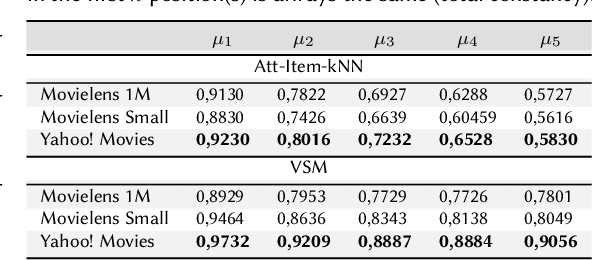
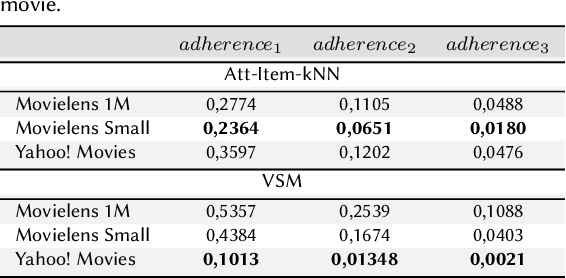
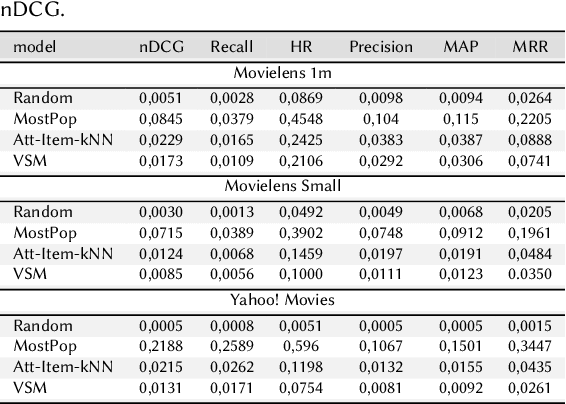
Abstract:Explainable Recommendation has attracted a lot of attention due to a renewed interest in explainable artificial intelligence. In particular, post-hoc approaches have proved to be the most easily applicable ones to increasingly complex recommendation models, which are then treated as black-boxes. The most recent literature has shown that for post-hoc explanations based on local surrogate models, there are problems related to the robustness of the approach itself. This consideration becomes even more relevant in human-related tasks like recommendation. The explanation also has the arduous task of enhancing increasingly relevant aspects of user experience such as transparency or trustworthiness. This paper aims to show how the characteristics of a classical post-hoc model based on surrogates is strongly model-dependent and does not prove to be accountable for the explanations generated.
Reenvisioning Collaborative Filtering vs Matrix Factorization
Jul 28, 2021



Abstract:Collaborative filtering models based on matrix factorization and learned similarities using Artificial Neural Networks (ANNs) have gained significant attention in recent years. This is, in part, because ANNs have demonstrated good results in a wide variety of recommendation tasks. The introduction of ANNs within the recommendation ecosystem has been recently questioned, raising several comparisons in terms of efficiency and effectiveness. One aspect most of these comparisons have in common is their focus on accuracy, neglecting other evaluation dimensions important for the recommendation, such as novelty, diversity, or accounting for biases. We replicate experiments from three papers that compare Neural Collaborative Filtering (NCF) and Matrix Factorization (MF), to extend the analysis to other evaluation dimensions. Our contribution shows that the experiments are entirely reproducible, and we extend the study including other accuracy metrics and two statistical hypothesis tests. We investigated the Diversity and Novelty of the recommendations, showing that MF provides a better accuracy also on the long tail, although NCF provides a better item coverage and more diversified recommendations. We discuss the bias effect generated by the tested methods. They show a relatively small bias, but other recommendation baselines, with competitive accuracy performance, consistently show to be less affected by this issue. This is the first work, to the best of our knowledge, where several evaluation dimensions have been explored for an array of SOTA algorithms covering recent adaptations of ANNs and MF. Hence, we show the potential these techniques may have on beyond-accuracy evaluation while analyzing the effect on reproducibility these complementary dimensions may spark. Available at github.com/sisinflab/Reenvisioning-the-comparison-between-Neural-Collaborative-Filtering-and-Matrix-Factorization
Point-of-Interest Recommender Systems: A Survey from an Experimental Perspective
Jun 18, 2021



Abstract:Point-of-Interest recommendation is an increasing research and developing area within the widely adopted technologies known as Recommender Systems. Among them, those that exploit information coming from Location-Based Social Networks (LBSNs) are very popular nowadays and could work with different information sources, which pose several challenges and research questions to the community as a whole. We present a systematic review focused on the research done in the last 10 years about this topic. We discuss and categorize the algorithms and evaluation methodologies used in these works and point out the opportunities and challenges that remain open in the field. More specifically, we report the leading recommendation techniques and information sources that have been exploited more often (such as the geographical signal and deep learning approaches) while we also alert about the lack of reproducibility in the field that may hinder real performance improvements.
Analysing the Effect of Recommendation Algorithms on the Amplification of Misinformation
Mar 26, 2021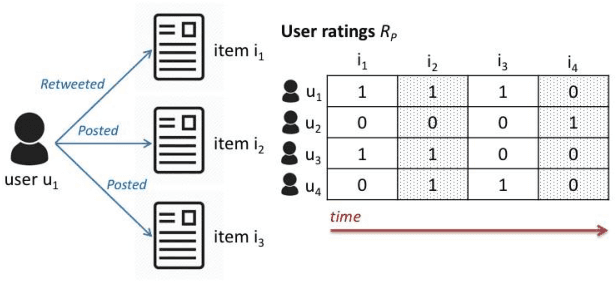
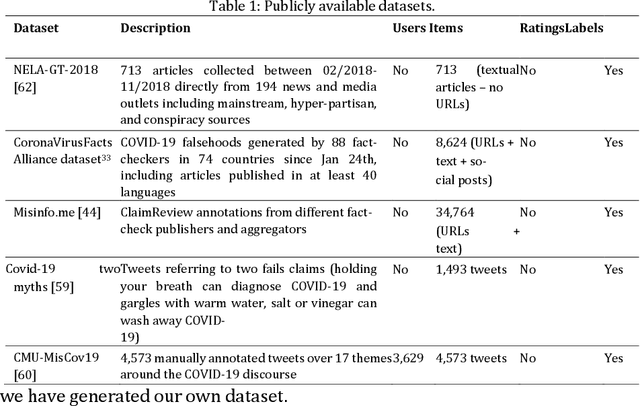
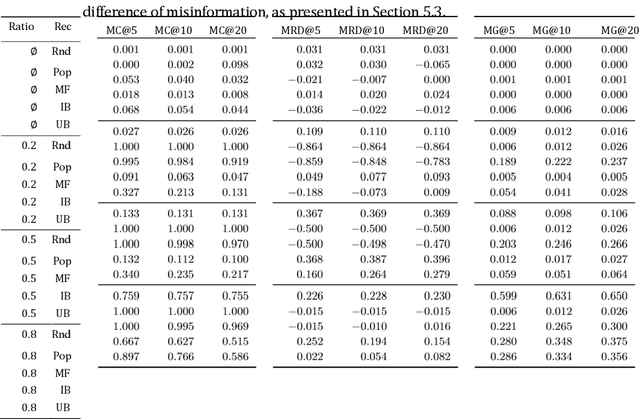
Abstract:Recommendation algorithms have been pointed out as one of the major culprits of misinformation spreading in the digital sphere. However, it is still unclear how these algorithms really propagate misinformation, e.g., it has not been shown which particular recommendation approaches are more prone to suggest misinforming items, or which internal parameters of the algorithms could be influencing more on their misinformation propagation capacity. Motivated by this fact, in this paper we present an analysis of the effect of some of the most popular recommendation algorithms on the spread of misinformation in Twitter. A set of guidelines on how to adapt these algorithms is provided based on such analysis and a comprehensive review of the research literature. A dataset is also generated and released to the scientific community to stimulate discussions on the future design and development of recommendation algorithms to counter misinformation. The dataset includes editorially labelled news items and claims regarding their misinformation nature.
Elliot: a Comprehensive and Rigorous Framework for Reproducible Recommender Systems Evaluation
Mar 03, 2021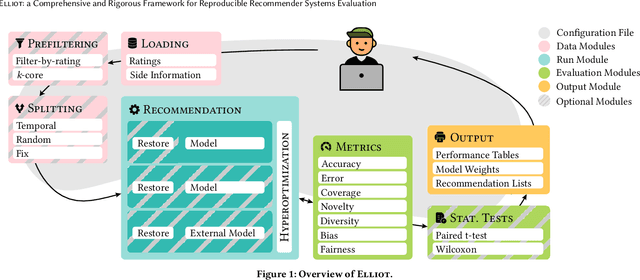
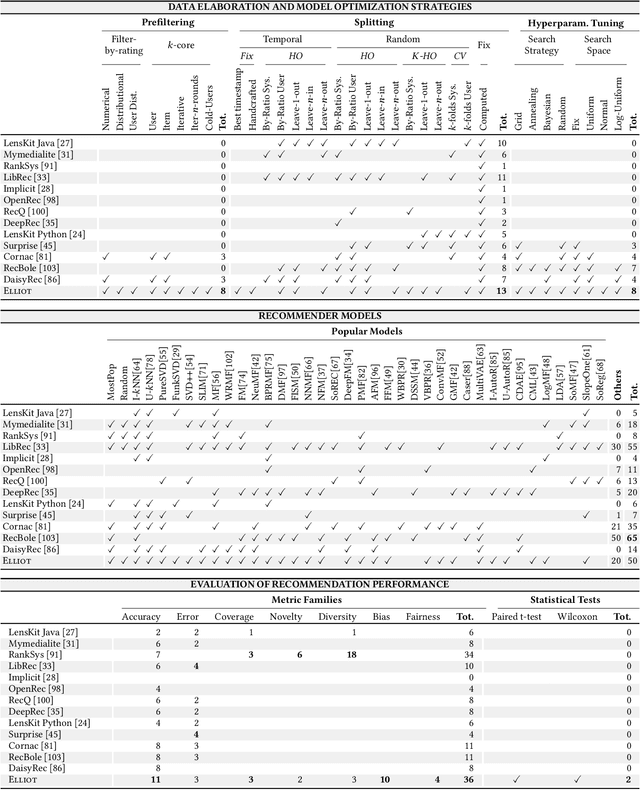
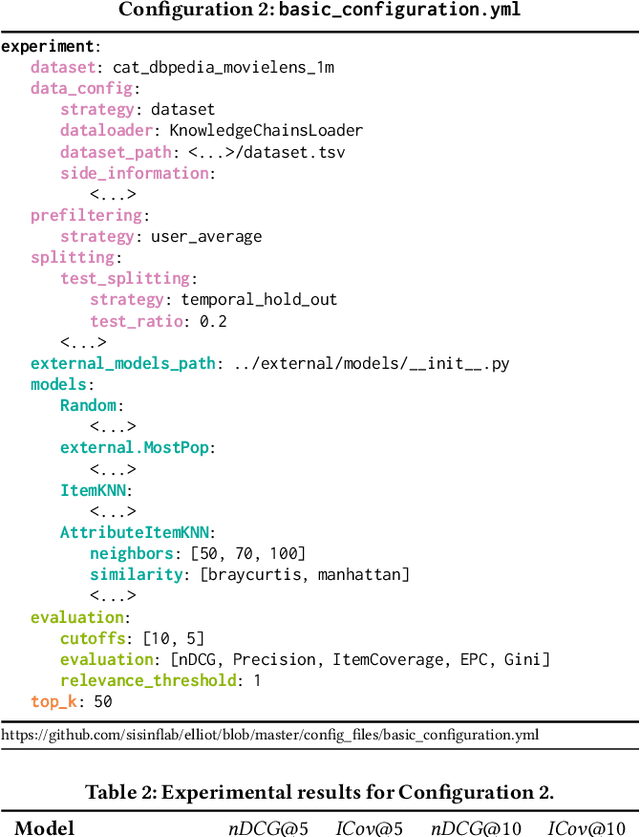
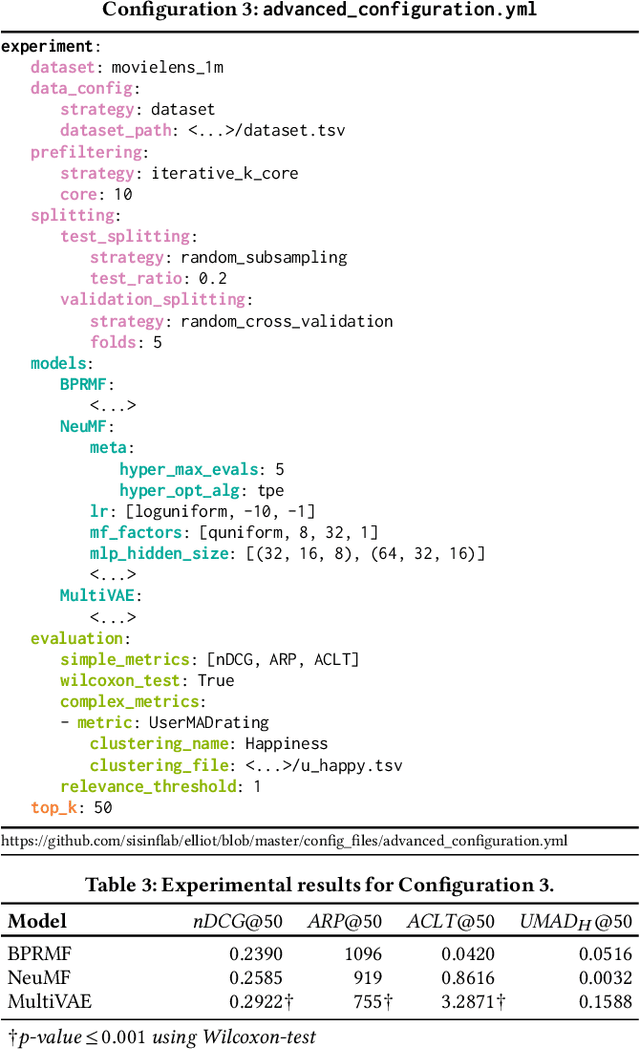
Abstract:Recommender Systems have shown to be an effective way to alleviate the over-choice problem and provide accurate and tailored recommendations. However, the impressive number of proposed recommendation algorithms, splitting strategies, evaluation protocols, metrics, and tasks, has made rigorous experimental evaluation particularly challenging. Puzzled and frustrated by the continuous recreation of appropriate evaluation benchmarks, experimental pipelines, hyperparameter optimization, and evaluation procedures, we have developed an exhaustive framework to address such needs. Elliot is a comprehensive recommendation framework that aims to run and reproduce an entire experimental pipeline by processing a simple configuration file. The framework loads, filters, and splits the data considering a vast set of strategies (13 splitting methods and 8 filtering approaches, from temporal training-test splitting to nested K-folds Cross-Validation). Elliot optimizes hyperparameters (51 strategies) for several recommendation algorithms (50), selects the best models, compares them with the baselines providing intra-model statistics, computes metrics (36) spanning from accuracy to beyond-accuracy, bias, and fairness, and conducts statistical analysis (Wilcoxon and Paired t-test). The aim is to provide the researchers with a tool to ease (and make them reproducible) all the experimental evaluation phases, from data reading to results collection. Elliot is available on GitHub (https://github.com/sisinflab/elliot).
 Add to Chrome
Add to Chrome Add to Firefox
Add to Firefox Add to Edge
Add to Edge